Cloud-Based Single-Frequency Snapshot RTK Positioning
Abstract
1. Introduction
- The first contribution of this work is the development of a novel algorithm that ensures a nanosecond level absolute timing accuracy so that satellite positions can be computed with a much higher accuracy as well.
- The present research also addresses the problems brought by the lack of knowledge of the encoded navigation data bits, noted as the data bit ambiguity issue in this manuscript. This issue impacts the fractional carrier phase measurements and determines the possibility of obtaining an SRTK fixed solution, a method is proposed in this work to tackle this issue.
- The two previous innovations, as well as an improved data processing workflow of the novel SRTK algorithm, builds on top of our previous work [12]. To the best of our knowledge, this is the first time that snapshot signals have been used to generate RTK fixed solutions under a non-zero baseline configuration.
2. Methodology
2.1. Snapshot RTK Processing Workflow
2.2. Acquisition
2.3. Measurement Generation
2.3.1. Full Pseudorange Generation
- P represents the full pseudorange value, in meters;
- is the fractional code delay value obtained from the acquisition step, in seconds;
- stands for the code ambiguity, which is an integer value;
- T is the duration of a primary code periods, in seconds. For example, for GPS L1CA signal this value is 0.001 s and for Galileo E1C signal it equals to 0.004 s;
- c stands for the speed of light constant, in m/s.
2.3.2. Carrier Phase Half Cycle Compensation
2.3.3. Global Time Tag Determination
- is the transmission time for satellite k, in seconds;
- represents the global time tag to be determined in this step, in seconds;
- is a multiple of secondary code periods, and can be denoted by ;
- represents an integer that also needs to be determined in this step;
- is the duration of the secondary code for satellite k, in seconds;
- is the code delay that has been augmented by the correct navigation bit hypothesis, in seconds.
2.4. SRTK Performance
2.4.1. RTK Filter
- is the DD operator;
- P and are the pseudorange in the m and carrier phase measurement in cycles, respectively;
- is the signal wavelength for carrier frequency i, in m;
- T and I are the Troposphere and Ionosphere delay, respectively, in m;
- represents the measurement noise, in m;
- N stands for the carrier phase integer ambiguity.
2.4.2. Parameters of Interest
- S is the size of the snapshot data, in bits;
- Q represtns the constant quantization parameter, in bits per sample;
- stands for the sampling rate, in Hz;
- T is the total integration time, in s;
- A stands for the size of additional data, in bits.
3. Experiment Setup and Results
3.1. Data Collection
3.2. Experiment Setup
- Integration time (ms): ;
- Signal bandwidth (MHz): ;
- Baseline distance (km): .
3.3. Results and Discussions
3.3.1. Baseline Distance Impact
3.3.2. Signal Bandwidth Impact
3.3.3. Integration Time Impact
3.3.4. Snapshot Size
3.3.5. Positioning Accuracy
4. Conclusions
Author Contributions
Funding
Data Availability Statement
Acknowledgments
Conflicts of Interest
Abbreviations
| CAF | Cross Ambiguity Function |
| CEP | Circular Error Probable |
| CRB | Cramer-Rao Bound |
| CTN | Coarse Time Navigation |
| DD | Double Difference |
| DOP | Dilution Of Precision |
| GNSS | Global Navigation Satellite System |
| IAR | Integer Ambiguity Resolution |
| IF | Intermediate Frequency |
| IoT | Internet of Things |
| LAMBDA | Least-squares Ambiguity Decorrelation Adjustment |
| LBS | Location Based Service |
| LRF | LAMBDA Ratio Factor |
| PRN | Pseudo Random Noise |
| PVT | Position Velocity Time |
| RAIM | Receiver Autonomous Integrity Monitoring |
| RMS | Root Mean Square |
| RTK | Real Time Kinematics |
| SD | Single Difference |
| SNR | Signal to Noise Ratio |
| TEC | Total Electron Content |
| TOW | Time Of Week |
| VRS | Virtual Reference Station |
| ZTD | Zenith Total Delay |
References
- European GNSS Agency (GSA). GNSS Market Report; Publications Office of the European Union: Luxembourg, 2019. [Google Scholar] [CrossRef]
- Dardari, D.; Closas, P.; Djurić, P.M. Indoor tracking: Theory, methods, and technologies. IEEE Trans. Veh. Technol. 2015, 64, 1263–1278. [Google Scholar] [CrossRef]
- Amin, M.G.; Closas, P.; Broumandan, A.; Volakis, J.L. Vulnerabilities, threats, and authentication in satellite-based navigation systems [scanning the issue]. Proc. IEEE 2016, 104, 1169–1173. [Google Scholar] [CrossRef]
- Kassas, Z.M.; Closas, P.; Gross, J. Navigation systems panel report navigation systems for autonomous and semi-autonomous vehicles: Current trends and future challenges. IEEE Aerosp. Electron. Syst. Mag. 2019, 34, 82–84. [Google Scholar] [CrossRef]
- Morton, Y.J.; van Diggelen, F.; Spilker, J.J., Jr.; Parkinson, B.W.; Lo, S.; Gao, G. Position, Navigation, and Timing Technologies in the 21st Century, Volumes 1 and 2: Integrated Satellite Navigation, Sensor Systems, and Civil Applications, Set; John Wiley & Sons: Hoboken, NJ, USA, 2020. [Google Scholar]
- Langley, R.B. RTK GPS. GPS World 1998, 9, 70–76. [Google Scholar]
- Linty, N. Snapshot Estimation Algorithms for GNSS Mass-Market Receivers. Ph.D. Dissertation, Politecnico Di Torino, Torino, Italy, 2015. [Google Scholar]
- Van Dierendonck, K.; Al-Fanek, O. What Is Snapshot Positioning and What Advantages Does It Offer? Inside GNSS 2018, 6, 28–33. [Google Scholar]
- Lucas-Sabola, V.; Seco-Granados, G.; Lopez-Salcedo, J.; Garcia-Molina, J.; Crisci, M. Efficiency Analysis of Cloud GNSS Signal Processing for IoT Applications. In Proceedings of the 30th International Technical Meeting of The Satellite Division of the Institute of Navigation (ION GNSS 2017), Portland, OR, USA, 25–29 September 2017. [Google Scholar] [CrossRef]
- Jiménez-Baños, D.; Blanco-Delgado, N.; López-Risueño, G.; Seco-Granados, G.; Garcia-Rodríguez, A. Innovative Techniques for GPS Indoor Positioning Using a Snapshot Receiver. In Proceedings of the 19th International Technical Meeting of the Satellite Division of The Institute of Navigation (ION GNSS 2006), Fort Worth, TX, USA, 25–29 September 2006; pp. 2944–2955. [Google Scholar]
- Medina, D.; Ortega, L.; Vila-Valls, J.; Closas, P.; Vincent, F.; Chaumette, E. A New Compact CRB for Delay, Doppler and Phase Estimation—Application to GNSS SPP & RTK Performance Characterization. IET Radar Sonar Navig. 2020. [Google Scholar] [CrossRef]
- Liu, X.; Ángel Ribot, M.; Gusi-Amigó, A.; Closas, P.; Rovira-Garcia, A.; Sanz, J. RTK Feasibility Analysis for GNSS SnapshotPositioning. In Proceedings of the 33rd International Technical Meeting of the Satellite Division of The Institute of Navigation (ION GNSS+ 2020), Online, 22–25 September 2020; pp. 2911–2921. [Google Scholar] [CrossRef]
- Williams, N.; Wu, G.; Closas, P. Impact of positioning uncertainty on eco-approach and departure of connected and automated vehicles. In Proceedings of the 2018 IEEE/ION Position, Location and Navigation Symposium (PLANS), Monterey, CA, USA, 23–26 April 2018; pp. 1081–1087. [Google Scholar]
- Diggelen, F.V. A-GPS: Assisted GPS, GNSS and SBAS; Artech House: London, UK, 2009; Chapter 4; pp. 61–102. [Google Scholar]
- Blay, R.; Wang, B.; Akos, D.M. Deriving Accurate Time from Assisted GNSS Using Extended Ambiguity Resolution. NAVIGATION 2021, 68, 217–229. [Google Scholar] [CrossRef]
- Yoo, W.; Kim, L.; Lee, H. A coarse-time positioning method for improved availability. GPS Solut. 2019, 24, 2. [Google Scholar] [CrossRef]
- Morosi, S.; Martinelli, A.; Del Re, E. Peer-to-peer cooperation for GPS positioning. Int. J. Satell. Commun. Netw. 2017, 35, 323–341. [Google Scholar] [CrossRef]
- van Graas, F.; Soloviev, A.; Uijt de Haag, M.; Gunawardena, S. Closed-Loop Sequential Signal Processing and Open-Loop Batch Processing Approaches for GNSS Receiver Design. IEEE J. Sel. Top. Signal Process. 2009, 3, 571–586. [Google Scholar] [CrossRef]
- Foucras, M. Performance Analysis of Modernized GNSS Signal Acquisition. Ph.D. Thesis, Mathématiques, Informatique, Télécommunications de Toulouse (MITT), Ecole Nationale d’Aviation Civile (ENAC), Toulouse, France, 2015. [Google Scholar]
- Borio, D. A Statistical Theory for GNSS Signal Acquisition. Ph.D. Thesis, Politecnico di Torino, Turin, Italy, 2014. [Google Scholar]
- Corazza, G.; Palestini, C.; Pedone, R.; Villanti, M. Galileo Primary Code Acquisition Based on Multi-hypothesis Secondary Code Ambiguity Elimination. Int. J. Satell. Commun. Netw. 2007, 2, 2459–2465. [Google Scholar]
- Beyerle, G.; Ramatschi, M.; Galas, R.; Schmidt, T.; Wickert, J.; Rothacher, M. A data archive of GPS navigation messages. GPS Solut. 2009, 13, 35–41. [Google Scholar] [CrossRef][Green Version]
- van Diggelen, F.; Abraham, C. Coarse-Time AGPS; Computing TOW From Pseudorange Measurements, and the Effect on HDOP. In Proceedings of the 20th International Technical Meeting of the Satellite Division of The Institute of Navigation (ION GNSS 2007), Fort Worth, TX, USA, 25–28 September 2007; pp. 357–367. [Google Scholar]
- Parkinson, B.; Spilker, J.; Enge, P. Global Positioning System, Vols I and II, Theory and Applications; American Institute of Aeronautics: Reston, VA, USA, 1996. [Google Scholar]
- Muthuraman, K.; Brown, J.; Chansarkar, M. Coarse Time Navigation: Equivalence of Algorithms and Reliability of Time Estimates. In Proceedings of the 2012 International Technical Meeting of The Institute of Navigation, Newport Beach, CA, USA, 30 January 2012; pp. 1115–1138. [Google Scholar]
- Chen, H.; Wang, H.; Chiang, Y. A new coarse-time GPS positioning algorithm using combined Doppler and code-phase measurements. GPS Solut. 2014, 18, 541–551. [Google Scholar] [CrossRef]
- Wang, S.; Deng, J.; Lu, X.; Song, Z.; Xu, Y. A New GNSS Single-Epoch Ambiguity Resolution Method Based on Triple-Frequency Signals. ISPRS Int. J. Geo Inf. 2017, 6, 46. [Google Scholar] [CrossRef]
- Sanz, J.; Juan, J.M.; Hernández-Pajares, M. GNSS DATA PROCESSING, Volume I: Fundamentals and Algorithms; ESA Communications; ESTEC: Noordwijk, The Netherlands, 2013; Volume 1. [Google Scholar]
- Kim, D.; Langley, R.B. Improving Long-range RTK: Getting a Better Handle on the Biases. GPS World 2008, 19, 50–56. [Google Scholar]
- Takasu, T.; Yasuda, A. Development of the low-cost RTK-GPS receiver with an open source program package RTKLIB. In Proceedings of the International Symposium on GPS/GNSS, International Convention Center, Jeju, Korea, 18–19 March 2009. [Google Scholar]
- Teunissen, P.; Joosten, P.; Tiberius, C. A Comparison of TCAR, CIR and LAMBDA GNSS Ambiguity Resolution. In Proceedings of the ION GPS 2002, Portland, OR, USA, 24–27 September 2002; pp. 2799–2808. [Google Scholar]
- Teunissen, P.; Verhagen, S. On GNSS Ambiguity Acceptance Tests. In Proceedings of the IGNSS Symposium, Sydney, Australia, 4–6 December 2007; pp. 1–13. [Google Scholar]
- Weill, L. C/A Code Pseudoranging Accuracy—How Good Can It Get? In Proceedings of the 7th International Technical Meeting of the Satellite Division of The Institute of Navigation (ION GPS 1994), Salt Lake City, UT, USA, 20–23 September 1994; pp. 133–141. [Google Scholar]
- Pany, T.; Riedl, B.; Winkel, J.; Woerz, T.; Schweikert, R.; Niedermeier, H.; Lagrasta, S.; Lopez-Risueno, G.; Jiménez-Baños, D. Coherent integration time: The longer, the better. Inside GNSS 2009, 4, 52–61. [Google Scholar]
- Closas, P. Bayesian Signal Processing Techniques for GNSS Receivers: From Multipath Mitigation to Positioning. Ph.D. Thesis, Universitat Politecnica de Catalunya, Barcelona, Spain, 2009. [Google Scholar]
- Tsui, J.B. Fundamentals of Global Positioning System Receivers: A Software Approach, 2nd ed.; John Wiley & Sons, Inc.: Hoboken, NJ, USA, 2004; Chapter 6; pp. 117–118. [Google Scholar]
- Septentrio PolaNt-x MF. Available online: https://www.septentrio.com/en/products/antennas/polant-x-mf (accessed on 15 April 2021).
- Takasu, T. RTKLIB: Open Source Program Package for RTK-GPS. In Proceedings of the Free and Open Source Software for Geospatial Conference, Tokyo, Japan, 20–23 October 2009. [Google Scholar]



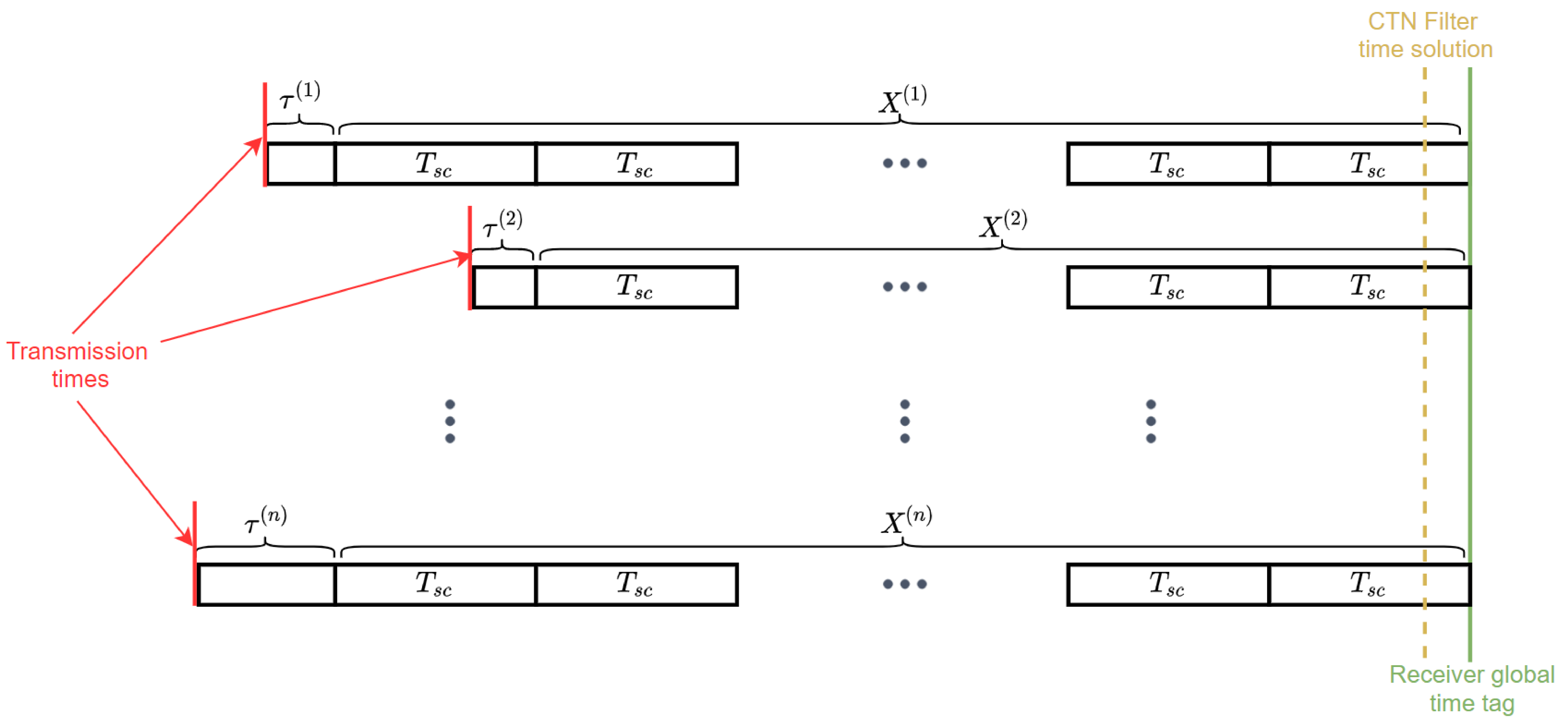

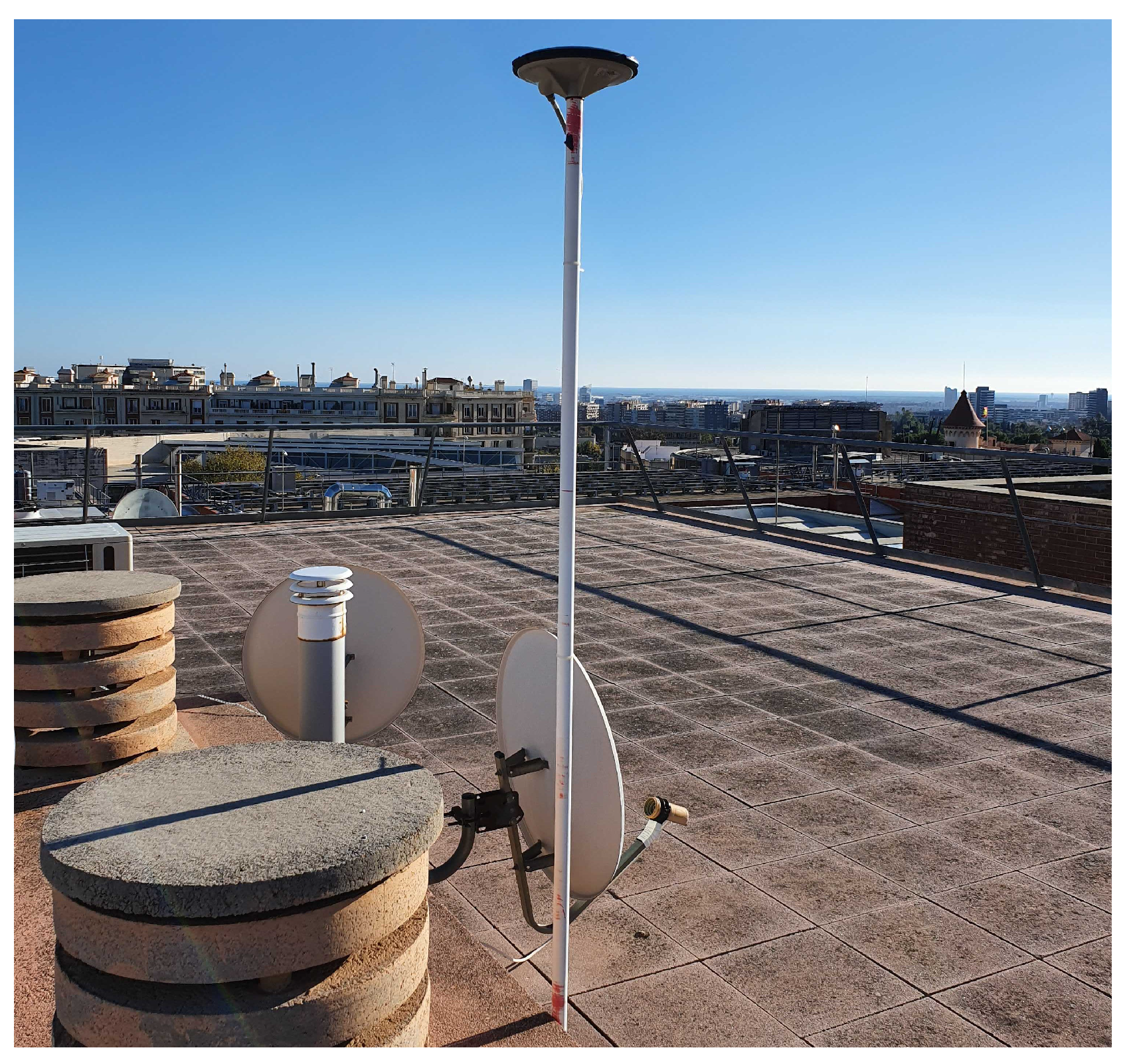
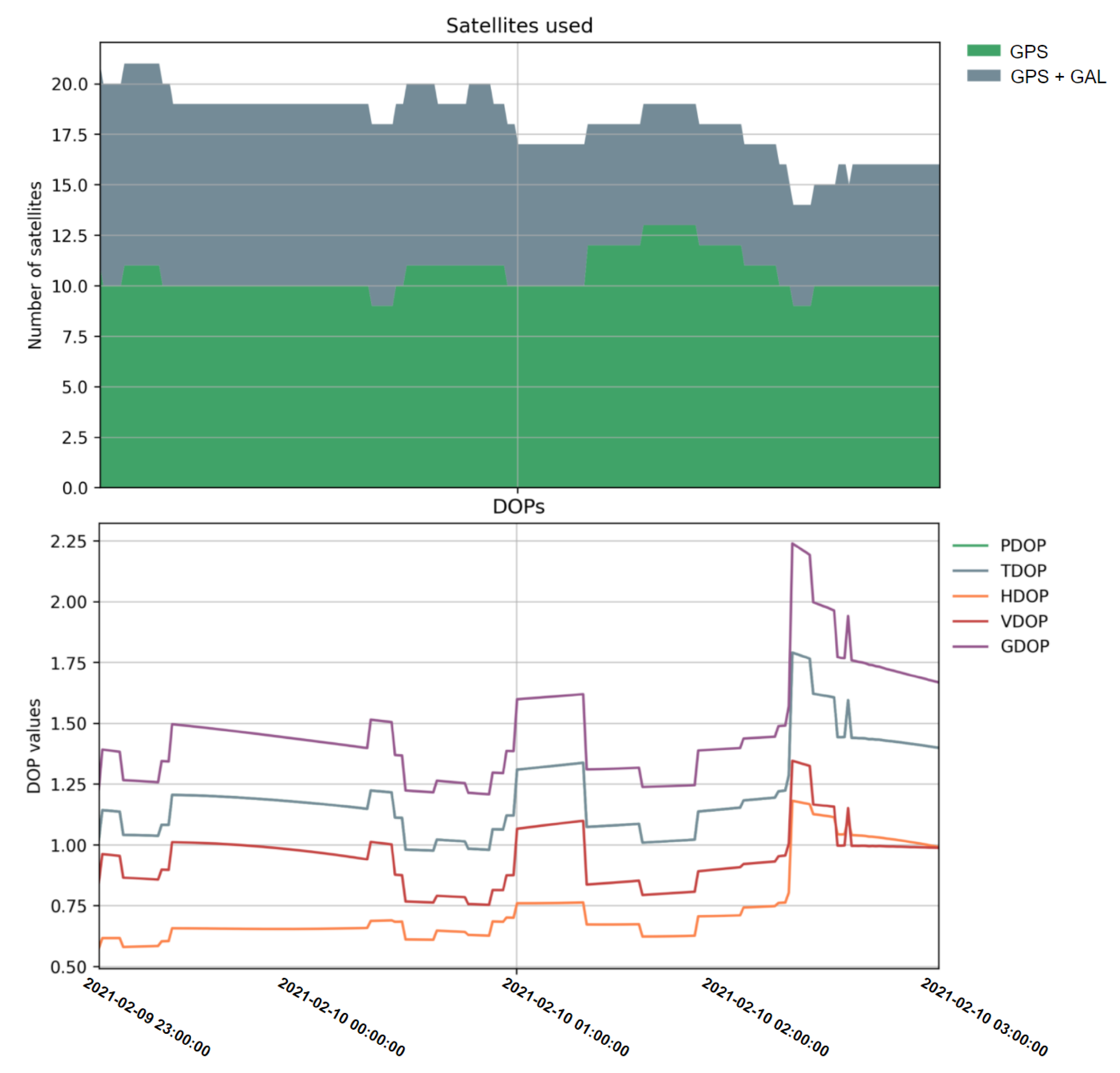
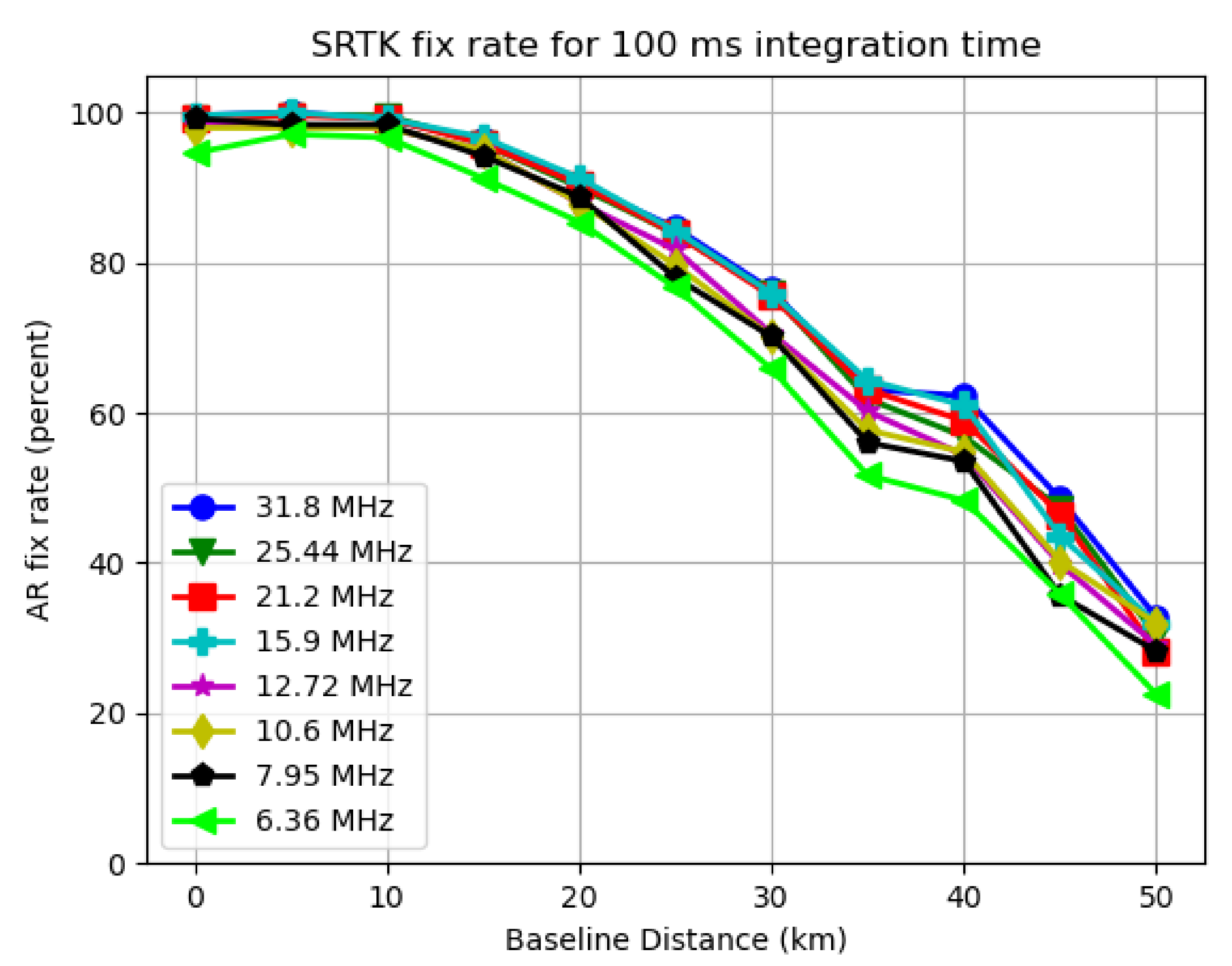
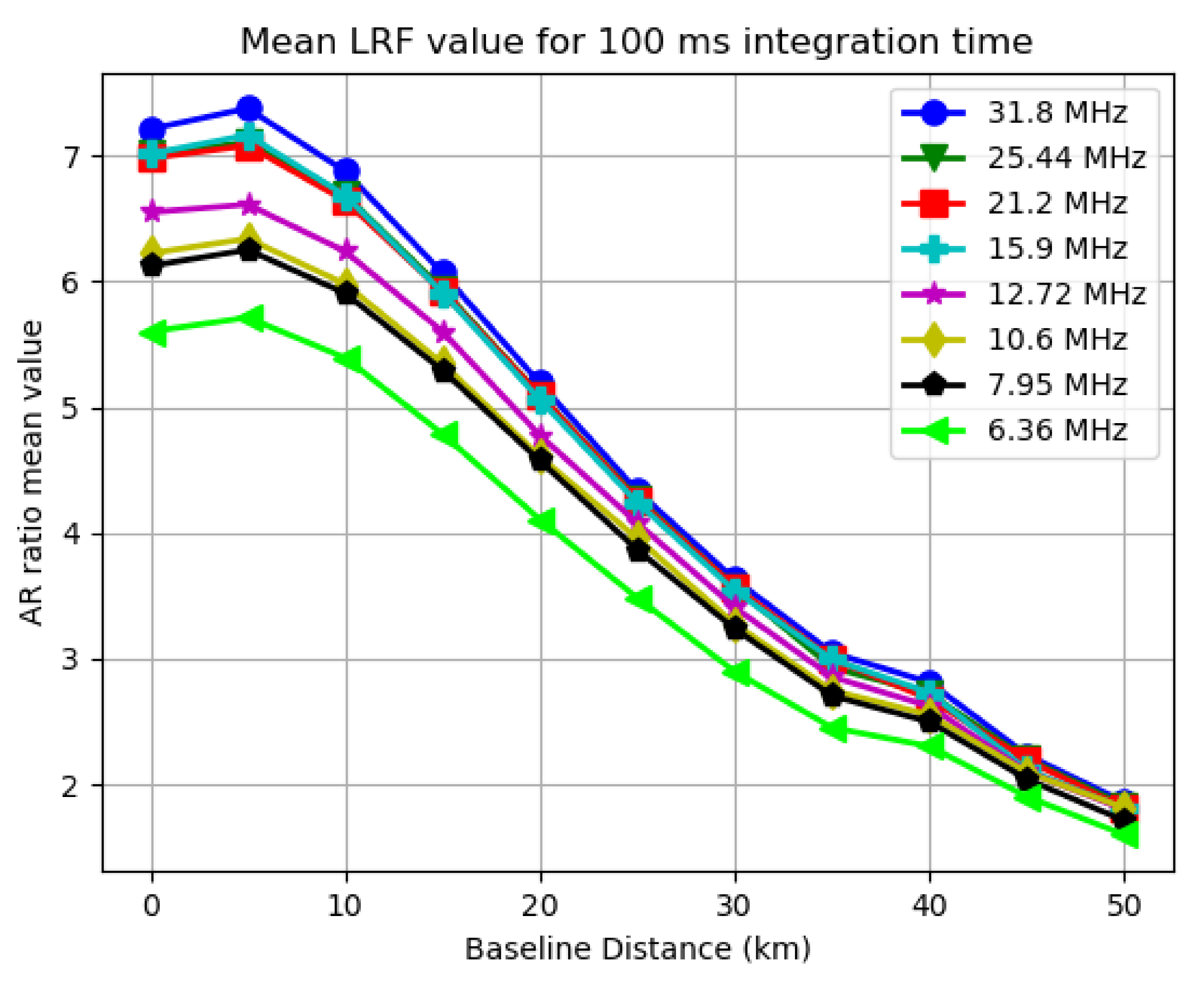
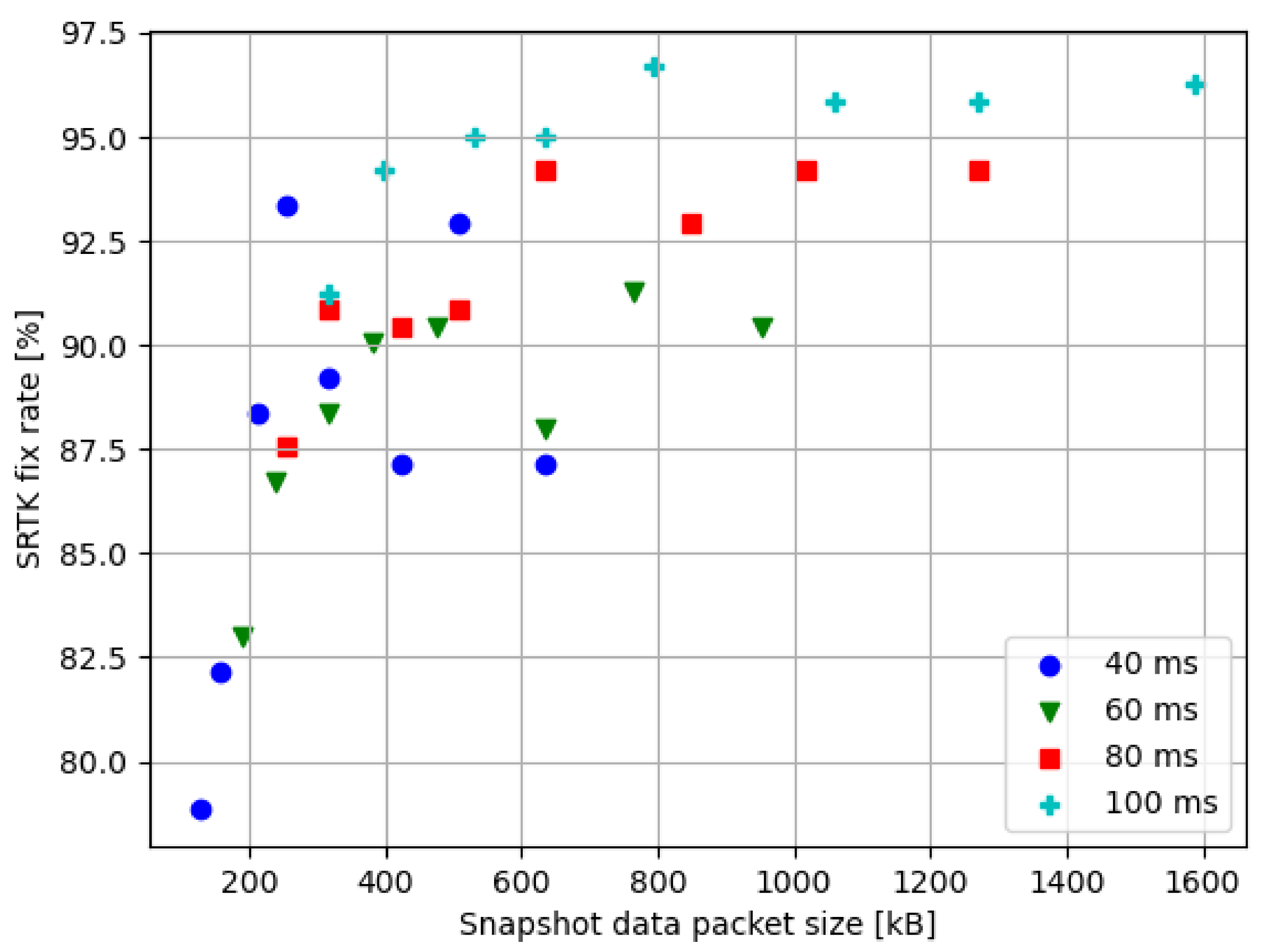
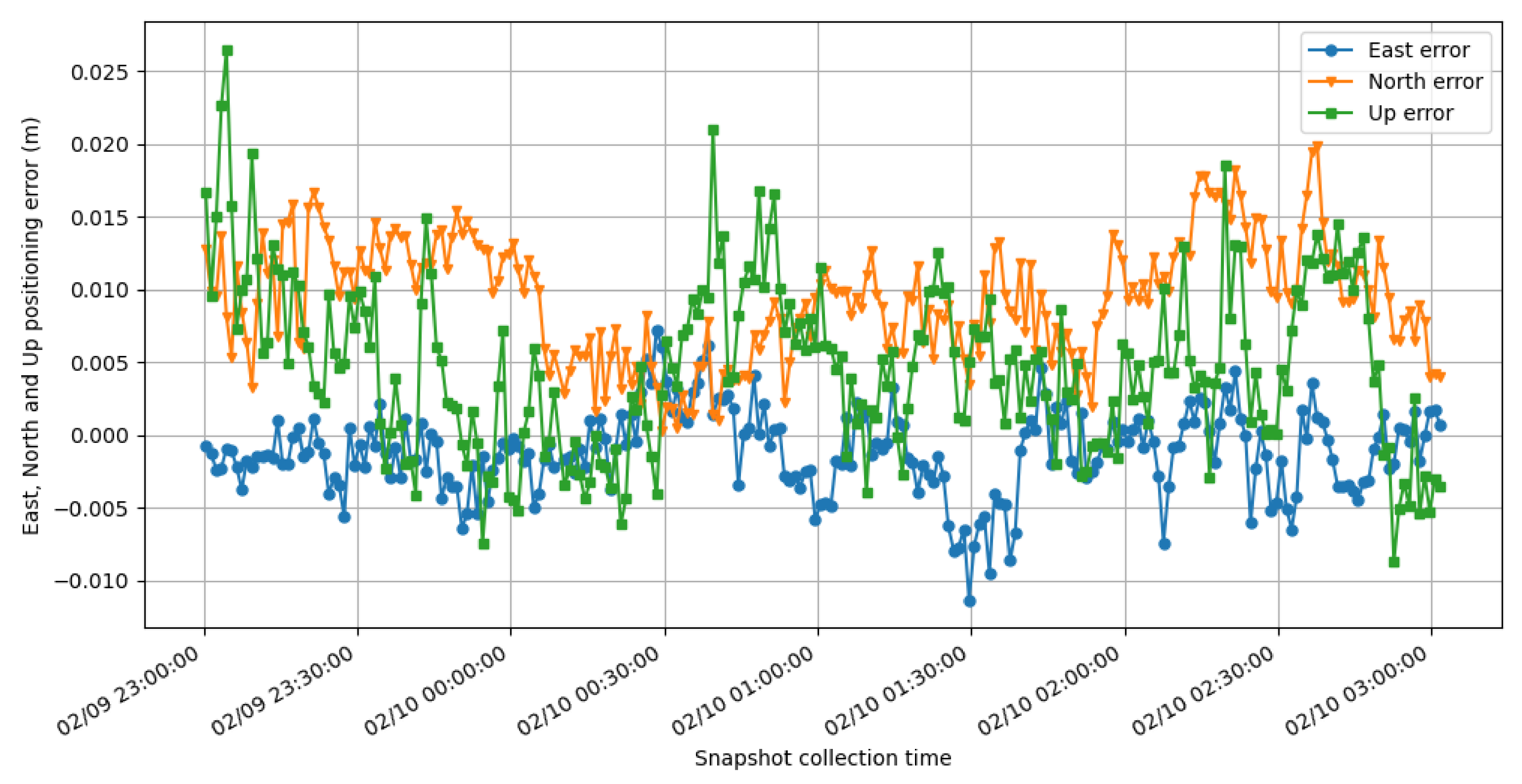

| 5 km | 10 km | 15 km | 20 km | 25 km | 30 km | 35 km | 40 km | 45 km | 50 km | |
|---|---|---|---|---|---|---|---|---|---|---|
| 40 ms | 92.53 | 90.87 | 87.14 | 82.16 | 74.69 | 66.39 | 53.11 | 51.45 | 40.66 | 31.54 |
| 60 ms | 95.44 | 95.02 | 90.46 | 84.65 | 78.01 | 70.54 | 55.6 | 46.89 | 37.34 | 28.63 |
| 80 ms | 98.34 | 98.76 | 94.19 | 88.38 | 80.91 | 74.69 | 59.34 | 56.02 | 43.98 | 27.8 |
| 100 ms | 100 | 99.17 | 96.27 | 90.46 | 84.65 | 76.35 | 63.07 | 62.24 | 48.55 | 32.78 |
| 5 km | 10 km | 15 km | 20 km | 25 km | 30 km | 35 km | 40 km | 45 km | 50 km | |
|---|---|---|---|---|---|---|---|---|---|---|
| 40 ms | 5.92 | 5.56 | 4.99 | 4.35 | 3.69 | 3.06 | 2.51 | 2.38 | 2.03 | 1.73 |
| 60 ms | 6.58 | 6.18 | 5.49 | 4.67 | 3.9 | 3.23 | 2.64 | 2.32 | 2.04 | 1.73 |
| 80 ms | 7.15 | 6.72 | 5.93 | 4.99 | 4.1 | 3.48 | 2.81 | 2.55 | 2.14 | 1.74 |
| 100 ms | 7.38 | 6.88 | 6.07 | 5.19 | 4.33 | 3.63 | 3.05 | 2.81 | 2.23 | 1.86 |
| 31.8 MHz | 25.44 MHz | 21.2 MHz | 15.9 MHz | 12.72 MHz | 10.6 MHz | 7.95 MHz | 6.36 MHz | |
|---|---|---|---|---|---|---|---|---|
| 40 ms | 636 | 508.8 | 424 | 318 | 254.4 | 212 | 159 | 127.2 |
| 87.14 | 92.95 | 87.14 | 89.21 | 93.36 | 88.38 | 82.16 | 78.84 | |
| 60 ms | 954 | 763.2 | 636 | 477 | 381.6 | 318 | 238.5 | 190.8 |
| 90.46 | 91.29 | 87.97 | 90.46 | 90.04 | 88.38 | 86.72 | 82.99 | |
| 80 ms | 1272 | 1017.6 | 848 | 636 | 508.8 | 424 | 318 | 254.4 |
| 94.19 | 94.19 | 92.95 | 94.19 | 90.87 | 90.46 | 90.87 | 87.55 | |
| 100 ms | 1590 | 1272 | 1060 | 795 | 636 | 530 | 397.5 | 318 |
| 96.27 | 95.85 | 95.85 | 96.68 | 95.02 | 95.02 | 94.19 | 91.25 |
Publisher’s Note: MDPI stays neutral with regard to jurisdictional claims in published maps and institutional affiliations. |
© 2021 by the authors. Licensee MDPI, Basel, Switzerland. This article is an open access article distributed under the terms and conditions of the Creative Commons Attribution (CC BY) license (https://creativecommons.org/licenses/by/4.0/).
Share and Cite
Liu, X.; Ribot, M.Á.; Gusi-Amigó, A.; Rovira-Garcia, A.; Sanz, J.; Closas, P. Cloud-Based Single-Frequency Snapshot RTK Positioning. Sensors 2021, 21, 3688. https://doi.org/10.3390/s21113688
Liu X, Ribot MÁ, Gusi-Amigó A, Rovira-Garcia A, Sanz J, Closas P. Cloud-Based Single-Frequency Snapshot RTK Positioning. Sensors. 2021; 21(11):3688. https://doi.org/10.3390/s21113688
Chicago/Turabian StyleLiu, Xiao, Miguel Ángel Ribot, Adrià Gusi-Amigó, Adria Rovira-Garcia, Jaume Sanz, and Pau Closas. 2021. "Cloud-Based Single-Frequency Snapshot RTK Positioning" Sensors 21, no. 11: 3688. https://doi.org/10.3390/s21113688
APA StyleLiu, X., Ribot, M. Á., Gusi-Amigó, A., Rovira-Garcia, A., Sanz, J., & Closas, P. (2021). Cloud-Based Single-Frequency Snapshot RTK Positioning. Sensors, 21(11), 3688. https://doi.org/10.3390/s21113688









